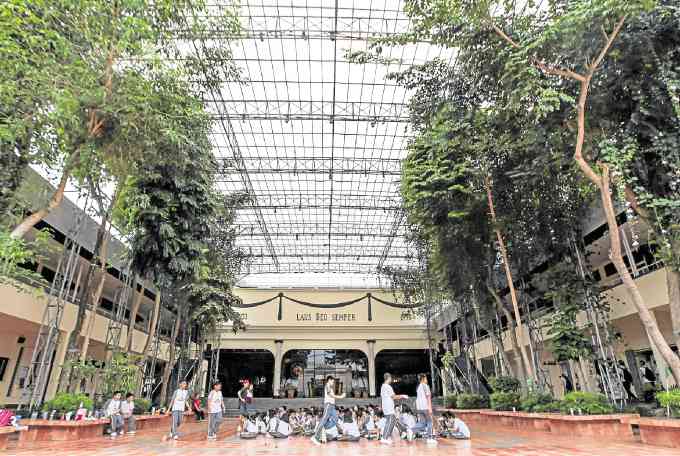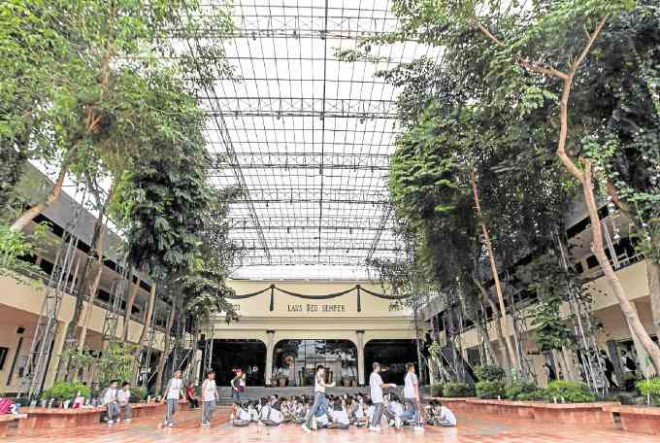
When twilight falls, tourists and expats flock like bats to a certain spot in Balibago, the entertainment district of Angeles City in Pampanga.
There’s a bar on one corner enticing passers-by with “free finger food with your drinks.” Not to be outdone, the bar next to it counters with a nightly finger-food competition. In the spirit of Christmas, a neighboring bar announces a Santa’s Lingerie Show.
This is the nerve center of the legendary Fields Avenue, also known as Walking Street (after the red-light district of Pattaya, Thailand ), about 500 meters of pedestrian road where tourists and locals rub elbows.
These go-go bars are remnants of those sprouting around the US air base in Angeles and the US naval base in Olongapo in Zambales some 25 years ago. Those twin Cities of the Plain were then known as Sin Cities. Angeles, especially, gained the dubious title Entertainment Capital of Central Luzon, and wags referred to it as the City of Lost Angels (referring to the streetwalkers, or their mixed-blood kids?).
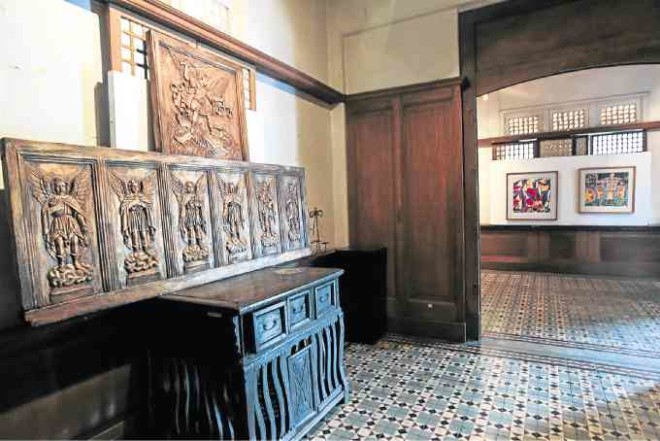
The city has a large Amerasian population—Caucasian mixed with Han Chinese and Japanese ancestry—such that the visitor would notice this trace evidence of fairer skin and more delicate features than in most Filipino ethnic groups.
A Time magazine report traces this to the sex industry: “During the American colonial period, over 800,000 Americans were born in the Philippines, and a large concentration of Filipinos with American ancestry were located in this city.” The presence of the US military base abetted the growth of the mestizo population.
Even after the US servicemen left Clark Air Base in the wake of the Mt. Pinatubo eruption in 1991, says Time, “the population of mixed-blood children continued to grow. By 1999, the visiting population of Angeles had shifted from young American GIs to boozy retirees.” That’s what we see on Fields Avenue now.
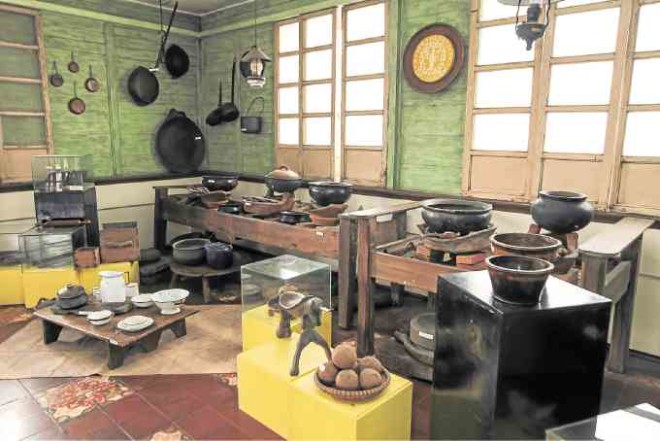
Top entertainers
High-end establishments have been constructed in the tourist belt to offset this acrid reputation, something that civic-minded Angeleños have been trying to shed since the Americans left.
They want to take off the wall, for instance, a vintage photograph from Asia Magazine showing a GI and a bar girl displayed in one section of Angeles Museum. This constitutes censorship and the curator would have none of it, insisting it should stay as it is part of the city’s history and reality.
In fact, Angeles’ reputation as entertainment center is quite apt, as many top entertainers trace their roots to this city: Lea Salonga, apl.de.ap (Allan Pineda Lindo), Hilda Koronel, Pepe Smith, Jaclyn José, Cris Judd, Donita Rose, Ryzza Mae Dizon.
Notable Angeleños also include Efren “Bata” Reyes, Rodolfo “Boy Samson” Luat, Arwind Santos, Peter Valdes, Kristine Johnson, Servillano Aquino (revolutionary general and Benigno “Ninoy” Aquino’s grandfather).
The city derived its name from its patrons Los Santos Angeles Custodios (Holy Guardian Angels) and its founder Angel Pantaleón de Miranda (gobernadorcillo of the provincial capital San Fernando).
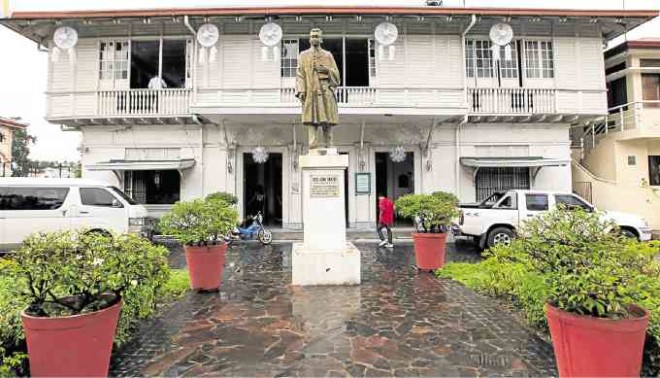
From a settlement out of a jungle clearing to a barrio of San Fernando, it became a separate municipality on Dec. 8, 1829. For four months it was the capital of the Philippines when Gen. Emilio Aguinaldo transferred the seat of the First Philippine Republic here.
The city’s numerous museums richly displaying Kapampangan culture and history should help rehabilitate the place and redeem its name.
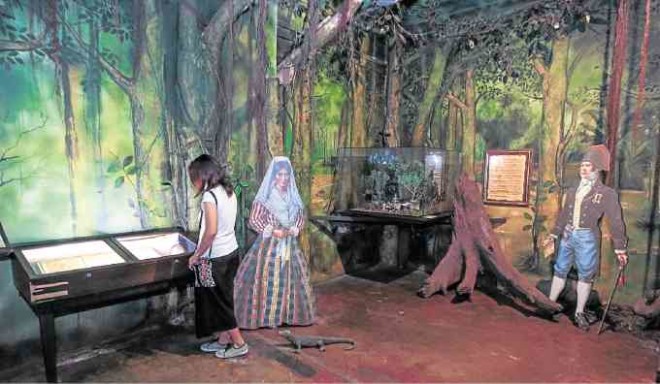
Premier museum
Museo ning Angeles in the heritage district of Santo Rosario stands right in front of Holy Rosary Church. This was the site of the casa tribunal (courthouse) which burned down in 1860.
The present building was constructed in 1922 and served as municipio del pueblo (town hall) until 1998. It was refurbished and opened as museum the following year. The city jail has been turned into the museum office, while the police station is now a souvenir shop.
Lucio Sison, city government tourism guide, and Joy Cruz, program officer for culture and heritage, annotate for visitors as they go through the museum’s four sections.
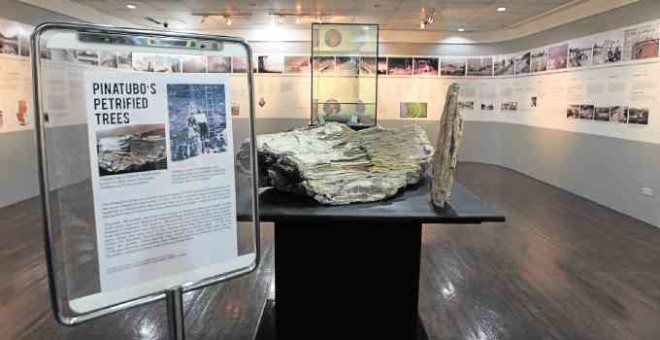
The old treasury office is now the Balikdan, a timeline gallery of old photographs and prints, dioramas, scale models, in several subsections: Culiat Is Born 1796 (life-size diorama of Angeles’ founder and his wife amid the clearing in the woodland entangled with culiat vines); Fort Stotsenburg 1902; Clark Field 1917; Angeles at War (artifacts from the Japanese occupation); The Turbulent 1960s (where the controversial 1968 photo of the GI and the bar girl is).
The assessor’s office is now Vicente Alvares Dizon Gallery, showcasing works of local artists. On permanent display are Claude Tayag’s watercolor pieces and wood reliefs of the Seven Archangels, the city’s patrons.
At the entrance is a copy of Dizon’s oil “After the Day’s Toil,” which unanimously won over works by Salvador Dali and Maurice Utrillo at the Golden Gate Expo in San Francisco in 1939. (Dizon’s contemporary Fernando Amorsolo also won first place in another world fair that year.)
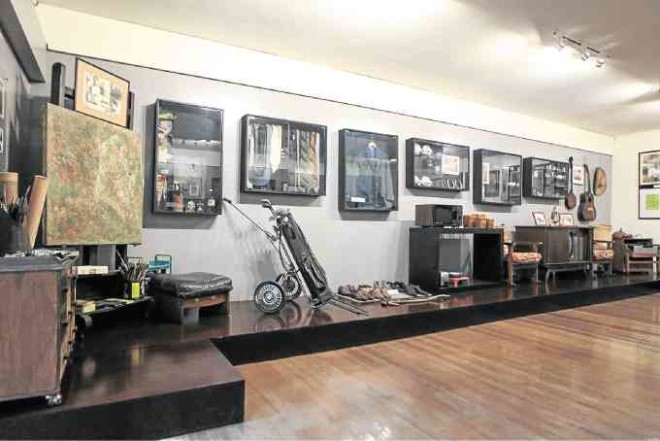
Culinary legacy
On the second floor, the mayor’s office became the Culinarium, a grand showcase of Pampanga’s reputation as the Culinary Capital of the Philippines. The entire floor is “dedicated to the Kapampangan culinary art and science that has emanated from the basic concept that the preparation of food is a heritage and a legacy worth preserving.”
Here are permanent exhibits of the typical Pampanga kitchen, dining room, table setting. Surrounding one hall are Edu Perreras’ hyperrealist paintings of eight Pampango dishes. Sisig is highlighted as the city is said to be its home.
Scattered around are 10 miniature dioramas fashioned by Beatriz “Patis” Pamintuan Tesoro, using her Nenita dolls to depict in tableaux vivants traditional town and country life in Pampanga.
In 2012, the National Museum declared the building an Important Cultural Property, the first in the country to be so declared.
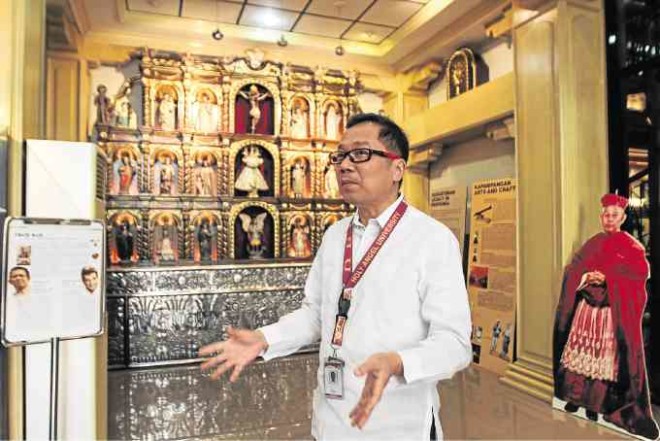
with altarpiece of patron saints in their original iconography
Cultural artifacts
Also in the vicinity is the Juan D. Nepomuceno Center for Kapampangan Studies. This was put up in 2002 in a three-story building within Holy Angel University. It has a library, archival museum, gallery, research center, theater. Robby Tantingco, the university’s vice president for student affairs, serves as its director.
At the entrance is a gallery of cultural artifacts with a retablo (side altar) as centerpiece. This one is not just a vessel of evangelization, but also a showcase of Kapampangan craftsmanship: upper part of wood crafted by Betis carvers; lower part of painted brass (poor man’s silver) done in pukpok (repoussé) by Apalit smiths; 22 wooden santos from Macabebe representing the patron saints of Pampanga’s 19 towns and three cities.
Strategically placed are the death masks of two of the country’s political and cultural icons with roots in the province—Fernando Poe Jr. and Ninoy Aquino—molded in plaster by National Artist Napoleon Abueva on the eve of their burial.
On one corner, encased in glass, are the laurel crowns of Pampanga’s poet laureates. Here are charts of basic information on the province’s literary men (Zoilo Galang and Crisostomo Soto from Bacolor, Aurelio Tolentino from Guagua); National Artists (Vicente Manansala, Benedicto Cabrera or BenCab, Ramon Zaragoza); folk festivals and rituals (lubenas, kuraldal, batalla, libad, sabat, aguman sanduk, ligligan parul).
Dumbfounding facts
In the next hall is a timeline that Tantingco says is a work in progress. It has empty slots that are filled as more information are added through the years.
Pampanga was created in 1571 (the same year as Manila), but, as the timeline traces it, its origin is dumbfounding. The chart shows that, while the first pyramids in Egypt were constructed in 2650 BC, there was boatbuilding in Candaba in 2000 BC (estimated from the age of stone adzes found there).
Displayed here are Candaba earthenware shards incised with designs that could be early baybayin from the Metal Age. (Archaeologist Robert Fox says the most extensive archeological excavation in the country is in Porac.)
Here also is a replica of a lantaka (bronze cannon) from the 17th-18th century, thought to be made by Panday Pira.
John Larkin Library holds books on Pampanga, photocopies of antique volumes and microfilms of church registry. Tantingco says it is meant to be a one-stop shop for research.
On the upper level is the Ambeth Ocampo Filipiniana Collection, with some 6,000 volumes.
The Archival Collection has an April 23, 1763, copy of the London paper General Evening Post with an item on the British occupation of Manila, describing Macabebe soldiers as “fierce and barbarous.”
Apl.de.ap. Music Studio and Library is used primarily by the hip-hop artist’s 20 scholars.
Museum of Kapampangan Arts, created from four classrooms, has a rotating exhibit of local artists, and a permanent one of Manansala’s personal effects and some 1,000 drawings and studies donated by his family.
Pinatubo Museum traces in art, artifacts and timeline the formation and eruption of Mt. Pinatubo from prehistory to the present.
Outside, in the courtyard, the activity area called Plaza San José, are planted indigenous trees that gave names to Pampanga towns: betis, apalit, balacat, dau, balete, bulaon, and the iconic vine culiat, the original name of Angeles.

